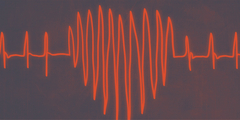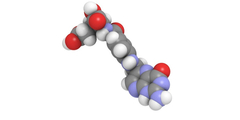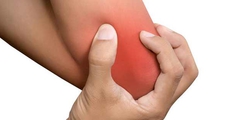
Ongeveer de helft van de premenopauzale vrouwen heeft gezondheidsklachten voorafgaande aan de menstruatie; drie tot negen procent van de vrouwen kampt met ernstige premenstruele klachten ofwel PMS (premenstrueel syndroom). PMDD (premenstrual dysphoric disorder) is een vorm van PMS waarbij ernstige psychische/psychosociale klachten op de voorgrond treden. Vooral vrouwen boven de dertig en vrouwen die kinderen hebben gekregen, krijgen last van PMS. De precieze oorzaak van PMS is onduidelijk. Ook zijn er relatief weinig wetenschappelijke studies gepubliceerd naar de werkzaamheid van voedingsstoffen en kruiden bij PMS/PMDD. Suppletie met calcium of monnikspeperbes en cognitieve gedragstherapie hebben vooralsnog de beste wetenschappelijke onderbouwing.1
Beste bezoeker, u heeft geen toegang.
Enkel (web)abonnees hebben toegang tot tijdschriftartikelen. Het webabonnement is nog in de maak.
U kunt zich wel alvast (gratis) registreren en tal van andere webartikelen raadplegen!
Auteur
Verschenen in
Referenties
Robinson LL et al. Clinical epidemiology of premenstrual disorder: informing optimized patient outcomes. Int J Womens Health. 2015;7:811-8.
Halbreich U et al. The prevalence, impairment, impact, and burden of premenstrual dysphoric disorder (PMS/PMDD). Psychoneuroendocrinology. 2003;28(suppl 3):1-23.
O’Brien S et al. Diagnosis and management of premenstrual syndrome. BMJ 2011;342:d2994.
Kadian S et al. Classification of premenstrual disorders as proposed by the International Society for Premenstrual Disorders. Menopause Int. 2012;18:43-7.
van der Leij F et al. Het premenstrueel syndroom. Ned Tijdschr Geneesk. 2010;154:A1341.
Nederlandse Vereniging voor Obstetrie en Gynaecologie (NVOG). Voorlichtingsbrochure premenstrueel syndroom. http://www.nvog.nl/Sites/Files/0000004489_Premenstrueel%20syndroom.pdf
Daily Record of Severity of Problems. http://www.aafp.org/afp/2011/1015/afp20111015p918-fig1.pdf
Htay TT et al. Premenstrual Dysphoric Disorder Clinical Presentation. http://emedicine.medscape.com/article/293257-clinical
Eriksson O et al. Women with premenstrual dysphoria lack the seemingly normal premenstrual right-sided relative dominance of 5-HTP-derived serotonergic activity in the dorsolateral prefrontal cortices - a possible cause of disabling mood symptoms. PLoS One. 2016;11(9):e0159538.
Gollenberg AL et al. Perceived stress and severity of perimenstrual symptoms: the BioCycle Study. J Womens Health (Larchmt). 2010;19(5):959-67.
Bertone-Johnson ER et al. Early life emotional, physical, and sexual abuse and the development of premenstrual syndrome: a longitudinal study. J Womens Health (Larchmt). 2014;23(9):729-39.
Girman A et al. An integrative medicine approach to premenstrual syndrome. Am J Obstet Gynecol. 2003;188(5 Suppl):S56–65.
Masho SW et al. Obesity as a risk factor for premenstrual syndrome. J Psychosom Obstet Gynaecol. 2005;26:33-39.
Bertone-Johnson ER et al. Cigarette smoking and the development of premenstrual syndrome. Am J Epidemiol. 2008;168(8):938-45.
Wittchen HU et al. Prevalence, incidence and stability of premenstrual dysphoric disorder in the community. Psychol Med. 2002;32:119-132.
Kim DR, Gyulai L, Freeman EW, et al. Premenstrual dysphoric disorder and psychiatric co-morbidity. Arch Womens Ment Health. 2004;7:37-47.
Duvan CI et al. Oxidant/antioxidant status in premenstrual syndrome. Arch Gynecol Obstet. 2011;283:299-304.
Gold EB et al. The association of inflammation with premenstrual symptoms. J Womens Health (Larchmt). 2016;25(9):865-74.
Bertone-Johnson ER et al. Association of inflammation markers with menstrual symptom severity and premenstrual syndrome in young women. Hum Reprod. 2014;29(9):1987-94.
Fanaei H et al. Effect of curcumin on serum brain-derived neurotrophic factor levels in women with premenstrual syndrome: A randomized, double-blind, placebo-controlled trial. Neuropeptides. 2016;56:25-31.
Cubeddu A et al. Brain-derived neurotrophic factor plasma variation during the different phases of the menstrual cycle in women with premenstrual syndrome. Psychoneuroendocrinology. 2011;36(4):523-30.
Matsumoto T et al. Altered autonomic nervous system activity as a potential etiological factor of premenstrual syndrome and premenstrual dysphoric disorder. BioPsychoSocial Med. 2007;1:24.
de Zambotti M et al. Autonomic regulation across phases of the menstrual cycle and sleep stages in women with premenstrual syndrome and healthy controls. Psychoneuroendocrinology. 2013;38(11):2618-27.
Baker FC et al. Reduced parasympathetic activity during sleep in the symptomatic phase of severe premenstrual syndrome. J Psychosom Res. 2008;65(1):13-22.
Bertone-Johnson ER et al. Calcium and vitamin D intake and risk of incident premenstrual syndrome. Arch Intern Med. 2005;165(11):1246-52.
Shobeiri F et al. Effect of calcium on premenstrual syndrome: A double-blind randomized clinical trial. Obstet Gynecol Sci 2017;60(1):100-105.
Bharati M. Comparing the effects of yoga & oral calcium administration in alleviating symptoms of premenstrual syndrome in medical undergraduates. J Caring Sci. 2016;5(3):179-185.
Tartagni M et al. Vitamin D supplementation for premenstrual syndrome-related mood disorders in adolescents with severe hypovitaminosis D. J Pediatr Adolesc Gynecol. 2016;29(4):357-61.
Parazzini F et al. Magnesium in the gynecological practice: a literature review. Magnes Res 2017;30(1):1-7.
dos Santos LA et al. Seric ion level and its relationship with the symptoms of premenstrual syndrome in young women. Nutr Hosp. 2013;28(6):2194-2200.
Fathizadeh N et al. Evaluating the effect of magnesium and magnesium plus vitamin B6 supplement on the severity of premenstrual syndrome. Iran J Nurs Midwifery Res. 2010;15(Suppl 1):401-5.
Brownley KA et al. Chromium supplementation for menstrual cycle-related mood symptoms. J Diet Suppl. 2013;10(4):345-56.
Fathizadeh S et al. Comparison of serum zinc concentrations and body antioxidant status between young women with premenstrual syndrome and normal controls: a case-control study. Int J Reprod BioMed. 2016;14(11):699-704.
Siahbazi S et al. Effect of zinc sulfate supplementation on premenstrual syndrome and health-related quality of life: clinical randomized controlled trial. J Obstet Gynaecol Res. 2017 Feb 11. doi: 10.1111/jog.13299.
Kashanian M et al. Pyridoxine (vitamin B6) therapy for premenstrual syndrome. Int J Gynecol Obs. 2007;96:43-44.
Sohrabi N et al. Evaluation of the effect of omega-3 fatty acids in the treatment of premenstrual syndrome: "a pilot trial". Complement Ther Med. 2013;21(3):141-6.
Brown J et al. Selective serotonin reuptake inhibitors for premenstrual syndrome. Cochrane Database of Systematic Reviews 2009, Issue 2, Art. No.: CD001396.
Turner EH et al. Serotonin a la carte: supplementation with the serotonin precursor 5-hydroxytryptophan. Pharmacol Ther. 2006;109(3):325-38.
van Die MD et al. Vitex agnus-castus extracts for female reproductive disorders: a systematic review of clinical trials. Planta Med 2013;79:562–575
Rafieian-Kopaei M et al. Systematic review of premenstrual, postmenstrual and infertility disorders of Vitex Agnus castus. Electron Physician. 2017;9(1):3685-3689.
Verkaik S et al. The treatment of premenstrual syndrome with preparations of Vitex agnus castus: a systematic review and meta-analysis. Am J Obstet Gynecol. 2017 Feb 22.
Carmichael AR. Can Vitex agnus castus be used for the treatment of mastalgia? What is the current evidence? eCAM 2008;5(3)247–250.
Momoeda M et al. Efficacy and safety of Vitex agnus-castus extract for treatment of premenstrual syndrome in Japanese patients: a prospective, open-label study. Adv Ther. 2014;31(3):362-73.
Webster DE et al. Opioidergic mechanisms underlying the actions of Vitex agnus-castus L. Biochem Pharmacol. 2011;81(1):170-7.
Ambrosini A et al. Use of Vitex agnus-castus in migrainous women with premenstrual syndrome: an open-label clinical observation. Acta Neurol Belg. 2013;113(1):25-9.
Dietz BM et al. Botanicals and their bioactive phytochemicals for women's health. Pharmacol Rev. 2016;68(4):1026-1073.
Khayat S et al. Curcumin attenuates severity of premenstrual syndrome symptoms: A randomized, double-blind, placebo-controlled trial. Complement Ther Med. 2015;23(3):318-24.
Agha-Hosseini M et al. Crocus sativus L. (saffron) in the treatment of premenstrual syndrome: a double-blind, randomised and placebo-controlled trial. BJOG. 2008;115(4):515-9.
Pirdadeh Beiranvand S et al. The effect of Crocus sativus (saffron) on the severity of premenstrual syndrome. Eur J Integr Med. 2015. http://dx.doi.org/10.1016/j.eujim.2015.06.003
Khayat S et al. Effect of treatment with ginger on the severity of premenstrual syndrome symptoms. ISRN Obstet Gynecol. 2014;2014:792708.
Stevinson C et al. A pilot study of Hypericum perforatum for the treatment of premenstrual syndrome. BJOG. 2000;107(7):870-6.
Canning S et al. The efficacy of Hypericum perforatum (St John's wort) for the treatment of premenstrual syndrome: a randomized, double-blind, placebo-controlled trial. CNS Drugs. 2010;24(3):207-25.
Ghazanfarpour M et al. Hypericum perforatum for the treatment of premenstrual syndrome. Int J Gynaecol Obstet. 2011;113(1):84-5.
Sharifi F et al. Comparison of the effects of Matricaria chamomila (Chamomile) extract and mefenamic acid on the intensity of premenstrual syndrome. Complement Ther Clin Pract. 2014;20(1):81-8.
Akbarzadeh M et al. Effect of Melissa officinalis capsule on the intensity of premenstrual syndrome symptoms in high school girl students. Nurs Midwifery Stud. 2015;4(2):e27001.
Matsumoto T et al. Does lavender aromatherapy alleviate premenstrual emotional symptoms?: a randomized crossover trial. BioPsychoSocial Medicine 2013;7:12.
Ozgoli G et al. A randomized, placebo-controlled trial of Ginkgo biloba L. in treatment of premenstrual syndrome. J Altern Complement Med. 2009;15(8):845-51.
Bryant M et al. Effect of consumption of soy isoflavones on behavioural, somatic, and affective symptoms in women with premenstrual syndrome. Br J Nutr. 2005;93(5):731-9.
Behboodi Moghadam Z et al. The effect of Valerian root extract on the severity of premenstrual syndrome symptoms. J Tradit Complement Med. 2016;6(3):309-15.
Farasati N et al. Western dietary pattern is related to premenstrual syndrome: a case-control study. Br J Nutr. 2015;114:2016-2021.
Vishnupriya R et al. Effects of aerobic exercise at different intensities in premenstrual syndrome. J Obstet Gynaecol India. 2011;61(6):675-682.
Kanojia S eta al. Effect of yoga on autonomic functions and psychological status during both phases of menstrual cycle in young healthy females. J Clin Diagn Res. 2013;7(10):2133-9.
Kim HW et al. Intake of dietary soy isoflavones in relation to perimenstrual symptoms of Korean women living in the USA. Nurs Health Sci. 2006;8(2):108-13.





